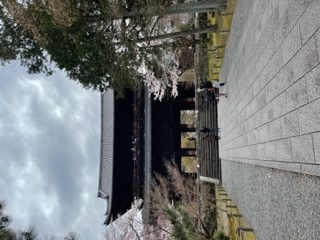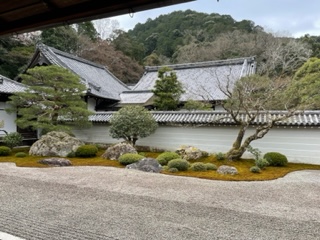Nanzen-ji 南禅寺

San-mon gate 三門

This temple has the distinction of being higher rank over The Five Mountains (Important Zen temples) of Kyoto. It contains many buildings which are designated National Treasures and Important Culture Properties, such as the San-mon gate which offer a superb view from its upper platforms, and the Hojo (ten foot squire hut) residence donated by Toyotomi Hideyoshi.
南禅寺は京都五山の上位にランクされた格式あるお寺で、楼上からの眺めが素晴らしい三門や、豊臣秀吉が寄進した方丈など、国宝や重要文化財の建物が多数あります。
Hojo-Teien Garden & Mizunomi-tora 方丈庭園と水吞み虎

In front of the Hojo (ten foot squire hut) residence is the Karesansui (dry landscape) style Hojo-teien garden said to have been created in the Edo period by Kobori Enshu. Among the things to see in the Ko-hojo (small ten foot squire hut) residence is a painting on a fusuma sliding screen entitled: Mizunomi-tora(Tiger drinking water). It is the work of Kano Tanyu, and date to the early Edo period.
方丈の前には江戸時代に小堀遠州が造ったと言われる枯山水の方丈庭園、子方丈には江戸時代初期に狩野探幽が描いた襖絵「水吞み虎」などの見どころ満載です。
Suiro-kaku & Nannzenn-in 水路閣と南禅院

At the rear of the temple precincts there is the arched red brick aqueduct Suiro-kaku, over which flows the Lake Biwa Cannal. The Nanzen-in sub temple, which lies still further on from the aqueduct, is the site of the Imperial Villa to which Emperor Kameyama went forth from home to homelessness and became a Cloistered Emperor. It is also the site of Nanzen-ji earliest origins. Its quiet garden, surrounded by trees, preserve the refinement of the Kamakura period.
境内奥には、琵琶湖疏水が流れる赤煉瓦製のアーチ構造の水路橋、水路閣があります。そのさらに先にある南禅院は、1289(正応2)年に亀山天皇が出家して法皇になった時の離宮の遺跡で、南禅寺発祥の地です。木々に囲まれた静かなたたずまいの庭は、鎌倉時代の趣をとどめています。
関連する投稿
現在の記事: Nanzen-ji 南禅寺






